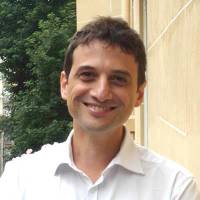Boris Adjemian Lecture Summary

Boris Adjemian (AGBU Nubar Library, Paris)
"Armenian Genocide Survivor Testimonies and the Evolution of Their Use"
October 16, 2017
In this lecture, Dr. Boris Adjemian speaks about the making of Armenian archival collections of victims' testimonies after the genocide and the evolution of their historiographical uses.
Historian Boris Adjemian gave a public lecture cosponsored by the USC Shoah Foundation Center for Advanced Genocide Research and the USC Institute of Armenian Studies about the making of Armenian archival collections of survivors’ testimonies after the Armenian genocide and the evolution of their historiographical uses. Dr. Adjemian began his lecture by discussing the history and collections of the AGBU Nubar Library in Paris, where he serves as Director. After its founding in 1928, the library was profoundly shaped by the decades-long work of Aram Andonian, himself a survivor after being arrested with many Armenian intellectuals in April 1915. Andonian became a pivotal figure in documenting the Armenian genocide.
After discussing Andonian, the library, and its significant and unique holdings, Dr. Adjemian moved on to detailing three archival collections of Armenian survivor testimonies that began shortly after the Armenian genocide, during World War I or shortly after the end of the war: testimonies gathered in the caucuses, a collection gathered by the Armenian Patriarchate of Constantinople, and testimonies collected by Andonian at the Nubar Library in Paris.
When evaluating archival collections of survivor testimonies from the Armenian genocide, Dr. Adjemian argued, it is necessary and valuable to analyze their production and organization, who the witnesses and survivors were, the forms of written and verbal narratives, the expectations of the actors who both gave and collected the testimonies, and the contributions of these testimonies to the history of the Armenian genocide. He explained that when considering all these factors, there are intriguing similarities and differences between the three collections.
For the corpus of testimonies from the caucuses, a 12-person team collected 600 testimonies in the areas of Yerevan and Tbilisi, where there were a lot of refugees. Established by the First Republic of Armenia 1918-1920, governed by the Armenian Revolutionary Federation, the team’s aim was to collect testimonies, official documents, photos, and reports of murders, rapes, kidnapping, and material losses.
The Armenian Patriarchate of Constantinople, which Ottoman Empire authorities had previously dissolved, reestablished itself and formed a Bureau of Information, which, led by historians and with the support of Allied powers, collected testimonies from deportees who had returned to Turkey after the war. The goal of gathering these testimonies was evidentiary in nature, preparing for trials of former Ottoman Empire rulers. Eyewitnesses and survivors were asked to write their testimonies following a standard and specific format. Most of the testimonies are between four and eight pages long. The Patriarchate collected around 1,500 survivor testimonies.
The third corpus Dr. Adjemian detailed is the Andonian corpus. There are 1,000 testimonies that are 4 to 5 pages each in this collection. These testimonies have both political and judiciary implications as they were gathered to help document accusations against former Ottoman Empire leaders.
After discussing a few of the similarities between these collections, Dr. Adjemian focused his remarks on how historians have regarded these survivor testimonies over the years. Despite the early existence of these testimonies, historians were reluctant to use them in their analysis of the Armenian genocide. Avoiding survivor testimonies they perceived as too subjective, historians instead gave priority to diplomatic and bureaucratic sources. As a result, for many years, historians largely studied the Armenian genocide from a diplomatic perspective. This resulted in a favoring of the point of view of the state and, at times, a reproduction of the perpetrator perspective. While there were some scholars who valued these testimonies, and several projects underway to collect testimonies, most historians and jurists neglected them for decades.
In the 1990s, there was a turning point in the historiography of the Armenian genocide when historians turned to testimonies and the wealth of information they contain about the conditions of life and death before, during, and after the genocide. This turning point is exemplified by Raymond Kévorkian's The Armenian Genocide: A Complete History.
Dr. Adjemian concluded his lecture by contemplating the impossibility of translating the suffering experienced during the genocide into words. Echoing passages from Andonian’s writing about how Andonian could not adequately approach the destruction experienced by his compatriots, Dr. Adjemian emphasized that testimonies are not mere sources of information for historians. Testimonies also represent the limits of historians’ knowledge and the limits of what academic research can bring to the comprehension of the genocide.
The discussion in the Q&A following Dr. Adjemian’s lecture covered many topics, including the methodological challenges of working with these collections, a more extended examination of the turning point when historians finally turned to the survivors' testimonies, and Dr. Adjemian’s analysis of the relations between genocide denial, survivor testimonies, and the historiography of the Armenian genocide.
Summary by Martha Stroud
Like this article? Get our e-newsletter.
Be the first to learn about new articles and personal stories like the one you've just read.